Stephen Bennett: Risk + Reward
by M. Stephen Doherty
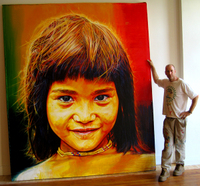
|
| Bennett standing beside his portrait of a Penan girl from Bario, Sarawak. |
Thirty years ago, Stephen Bennett left art school and the secure upstate-New York town where generations of his family had lived and began to establish himself as a professional artist. “I was expecting the New York art world to accept me on my terms,” he remembers. “Looking back, I realize I was making paintings more for myself and not for people to enjoy. Everything changed when I moved to Mexico and found a way of engaging the hospitable people who welcomed me. By giving myself the freedom to paint expressively and focusing my attention on creating pictures that would bring joy to others, a new world of possibilities opened up.”
Bennett now lives in New York City, but his art supplies are always packed and ready for the next adventure in Panama, Africa, Australia, Malaysia, Indonesia, or wherever his interests take him. He travels the globe creating paintings for an ongoing series about indigenous peoples, accepting commissions to paint portraits, and operating a nonprofit organization that encourages school children to draw and paint. He also mounts exhibitions of his massive acrylic portraits in galleries, building lobbies, community cultural centers, and museums. While portrait commissions provide the artist with a means of living, the public presentations raise awareness of various cultures as well as of Bennett’s work, and they encourage other people to experience the joy of painting.
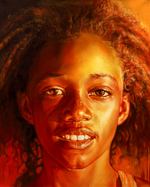
|
| Beach Baby (Seychelles) 2001, acrylic, 80 x 64. Collection the artist. |
Bennett’s portraits—which present tightly cropped faces of people the artist photographs during his travels—measure anywhere from 60" x 40" to 120" x 108", with the most recent series being 80" x 64". He works on the large surfaces while traveling, or he takes the photographs back to his studio and uses enlargements to trace the outlines of the facial features. Once the faces are drawn on the stretched canvas, the artist mixes Guerra pigments in emulsion with acrylic medium to establish either a limited or an expansive palette of colors. “For some of the portraits, such as Hulk of the Highlands and Beach Baby, I used only three or four colors in order to emphasize the power of the person’s eyes peering out from a monochromatic face; or I used more traditional palettes to capture the warm glow of sunlight on a young girl’s face. More often than not, I mix a wide range of bright colors so people can walk up to the paintings and feel excited about the dazzling display of pigments, or they can step back and see the richness, variety, and beauty in the face.”
|
The artist explains that he seldom employs traditional techniques of modulating warm and cool flesh colors or selecting pigments to match the exact appearance of the subject. “I’m interested in setting up color vibrations and making the combination of pigments pop,” he comments. “I use colors that respond to the personality of the subjects, and I strive for unexpected color combinations that, in the end, really do capture the texture, form, and appearance of the individual’s face.
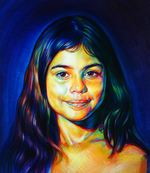
|
| Christina 2004, acrylic, 40 x 30. Private collection. |
“I want to give credit to my artist friend Joseph Marioni for introducing me to Guerra paints and pigments, and for helping me realize the benefit of working with bright, pure, high-quality pigments,” Bennett adds. “Joseph is a modernist painter whose strength is his use of color, and although my paintings are representational they are also about the connections between pigments, perceptions, and personalities.
“Whether I’m painting a tribesman in Papua New Guinea or American children whose parents hired me to create a portrait, there is always a metaphysical dynamic and a connection between me and the sitters,” Bennett continues. “I spend time getting to know the person so that the portrait results from a spiritual connection between us, and so viewers can sense the emotions we exchanged. I want the paintings to become stories of the lives of the subjects and the powerful transference that happens through the creative process.”
Although Bennett still uses oil to create about half of his paintings, when he travels he prefers to apply acrylic to paper and canvas to avoid the need for strong solvents and to facilitate the transport of paints from remote locations. “Because I frequently move from country to country and work in school rooms, private homes, small apartments, and public buildings, it isn’t possible to use solvents such as turpentine, mineral spirits, or linseed oil,” he explains. “Furthermore, I have to be able to roll up the large canvases the day after they are finished and carry them in a van or on a plane. Oil just doesn’t dry fast enough for that.”
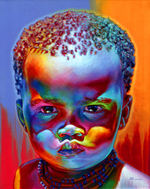
|
| Somehow Very Sure (Nambia) 2002, acrylic, 60 x 48. Private collection. |
Bennett also increased the sizes of his paintings so he could work more freely and give greater impact to the portraits. “I call myself an ‘arm painter,’ not a ‘wrist painter,’” he says. “That is, I am most comfortable when I can move a brush with the full motion of my arm and not just my fingers. But more important, the large scale of the paintings is appropriate for capturing the life force I feel when I meet someone, listen to the story of his or her life, and become captivated by the face that expresses what I’ve come to appreciate about the person. It’s ironic, I suppose, that to me the portraits are more ‘lifelike’ when the faces are 10 times life-size. I’ll work smaller on commissioned portraits that are intended for private homes, but I prefer to work on larger canvases when the portraits will be displayed in public spaces.”
Bennett says that although he is sometimes able to paint canvases up to 120" x 108", most are a maximum of 64 inches wide because of the limitations imposed by moving them from his New York loft to galleries. “I’m a tall guy, so my outstretched arms can grasp a 64-inch-wide stretched canvas, and I can maneuver it into a freight elevator. Anything larger and I either have to paint it where it will be hung or transport it unstretched and then restretch it when I put it on display.”
Although Bennett is completely sincere about his fascination with indigenous people and children around the world, the publicity generated by his newsworthy activities is extremely helpful in attracting commissions for portraits. That’s part of the reason he presents his work in both public places and private commercial galleries. “When I started developing 40"-x-60" portraits in Mexico, I recognized that painting local people enriched their lives, prompted people to laugh and joke, and gave them a sense of cultural pride. When I carried that idea to other places, I also saw that the paintings could attract a lot of positive attention and recognition. For example, after I spent time in Panama and exhibited 100 portraits in a show called ‘The Spirit of Panama,’ thousands of people came to a convention center to see my work. And then when I presented a museum exhibition of large portraits in Malaysia, more than 30,000 people came to view the show.
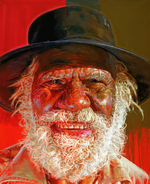
|
| Day Day Frank (Australia) 2003, acrylic, 80 x 64. Collection the artist. |
“Like every other artist, I faced the challenge of trying to make people aware of what I was doing in order to generate sales and commissions,” he says. “Fortunately, when 30,000 people make an effort to see an art exhibition, the paintings catch the attention of the news media and the general public. That helps build positive recognition for me and prompts sales and commissions. And although I’m happy to work with commercial galleries, many of the countries in which I work simply don’t have active gallery markets. That’s why I sometimes organize my own exhibitions in public places.”
Bennett has also found it helpful to donate portraits to charity auctions that can bring attention to his work. He has painted portraits of actors, television and sports personalities, and politicians; and he has allowed the paintings to be sold as a way of raising funds for nonprofit organizations.
Five years ago Bennett established a nonprofit of his own called Faces of the World. “Through the organization I have facilitated art workshops for thousands of children,” he explains. “The organization mounts exhibits of portrait paintings of children, artists, and local craftspeople. Ultimately, Faces of the World serves to preserve and celebrate indigenous culture by promoting education, cultural pride, ethno-ecotourism, and art.”

|
| Hulk of the Highlands (Papua New Guinea) 2007, acrylic, 80 x 64. Collection the artist. |
About the Artist
Stephen Bennett was raised in Amsterdam, New York, and attended the State University of New York at New Paltz, in upstate New York. He lives in New York City and creates commissioned portraits, but he makes annual trips around the world to paint portraits of indigenous peoples. He spent two years painting in Tanzania and Nambia, and has made other extended trips to Australia, Malaysia, Papua New Guinea, and Panama. For more information on Bennett, visit his website at www.theportraitpainter.com. For more information on Faces of the World, visit www.facesoftheworld.net.
M. Stephen Doherty is the editor-in-chief and publisher of American Artist.
To read more features like this, subscribe to American Artist today!

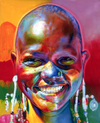
 Watercolor Highlights - Spring 2008
Watercolor Highlights - Spring 2008
Jun 2, 2008 2:25:53 PM
Absolutely Beautiful....